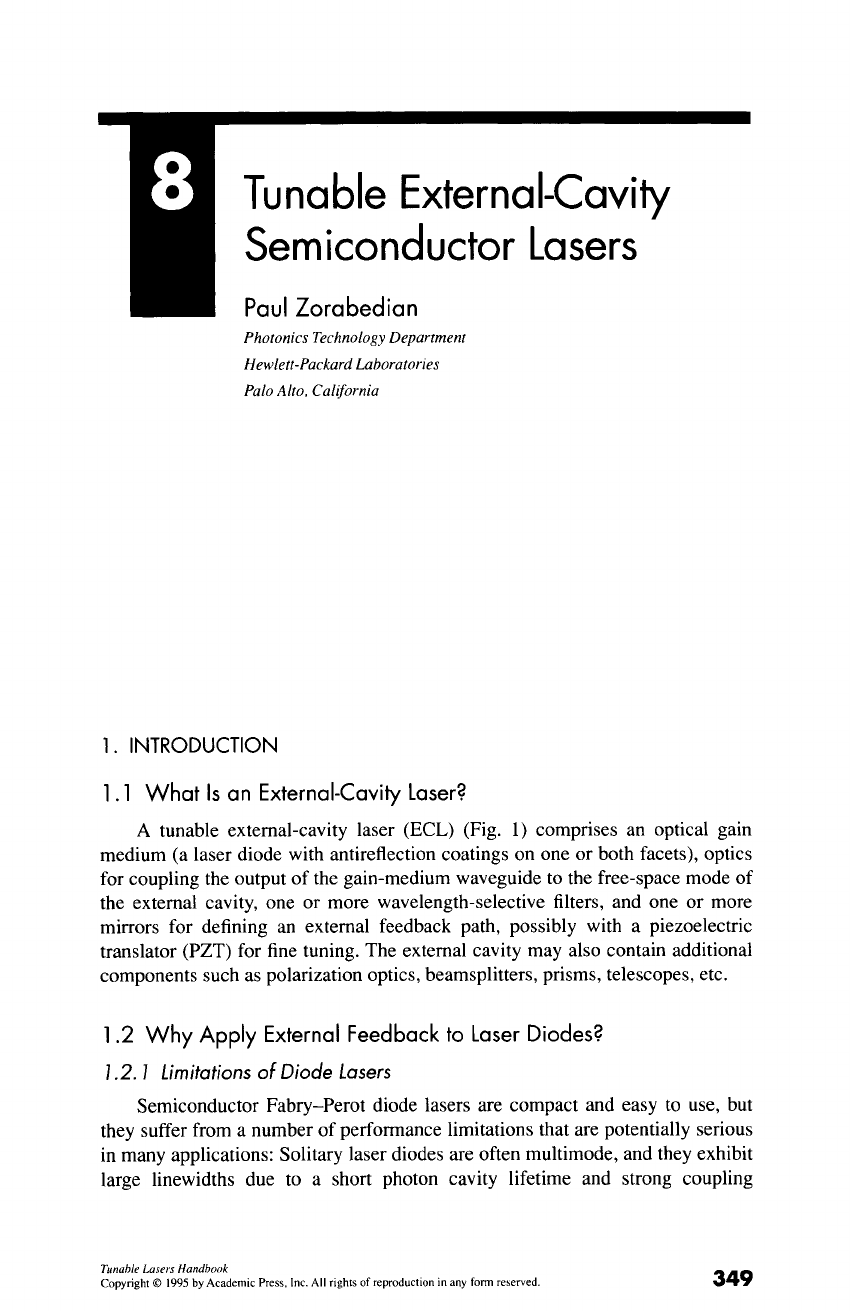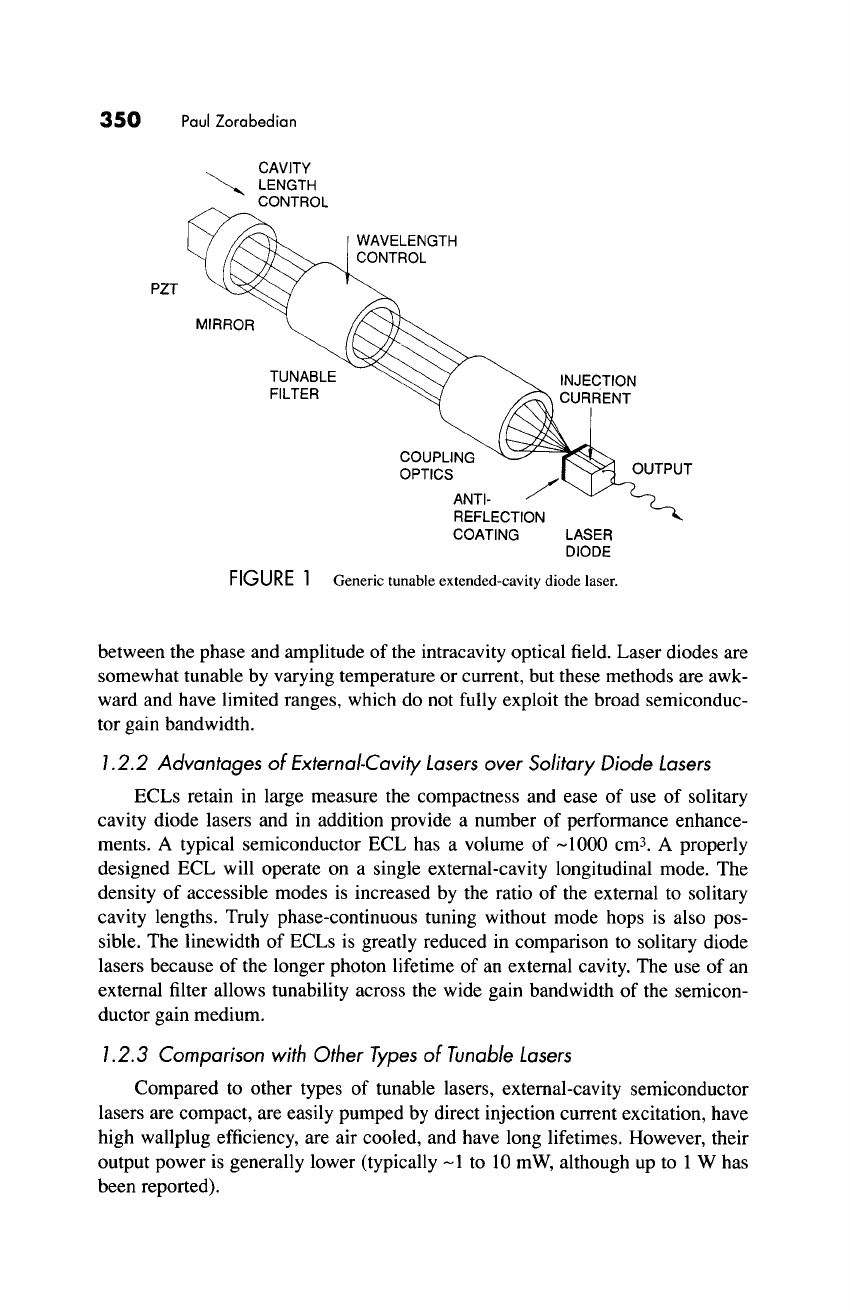
Tunable ExternaI-Cavily
Semiconductor Lasers
Paul Zorabedian
Photonics Technology Department
Hewlett-Packard Laboratories
Palo Alto, California
1. INTRODUCTION
1.1 What Is an External-Cavity Laser?
A tunable external-cavity laser (ECL) (Fig. 1) comprises an optical gain
medium (a laser diode with antireflection coatings on one or both facets), optics
for coupling the output of the gain-medium waveguide to the free-space mode of
the external cavity, one or more wavelength-selective filters, and one or more
mirrors for defining an external feedback path, possibly with a piezoelectric
translator (PZT) for fine tuning. The external cavity may also contain additional
components such as polarization optics, beamsplitters, prisms, telescopes, etc.
1.2 Why Apply External Feedback to Laser Diodes?
1.2.1 Limitations of Diode Lasers
Semiconductor Fabry-Perot diode lasers are compact and easy to use, but
they suffer from a number of performance limitations that are potentially serious
in many applications: Solitary laser diodes are often multimode, and they exhibit
large linewidths due to a short photon cavity lifetime and strong coupling
Tunable Lasers Handbook
Copyright 9 1995 by Academic Press, Inc. All rights of reproduction in any form reserved.
349

350 Paul Zorabedian
PZT
CAVITY
LENGTH
CONTROL
WAVELENGTH
~
... CONTROL
MIRROR
TUNABLE INJECTION
FILTER "~ (~U .RRENT
COUPLING ~ ~'~~.,. ......
OPTICS
....
.I ~~
ou,PuT
...... ANTI- /'J~'~
REFLECTION
COATING LASER
DIODE
FIGURE 1
Generic tunable extended-cavity diode laser.
between the phase and amplitude of the intracavity optical field. Laser diodes are
somewhat tunable by varying temperature or current, but these methods are awk-
ward and have limited ranges, which do not fully exploit the broad semiconduc-
tor gain bandwidth.
1.2.2 Advantages of External-Cavil/Lasers over Solitary Diode Lasers
ECLs retain in large measure the compactness and ease of use of solitary
cavity diode lasers and in addition provide a number of performance enhance-
ments. A typical semiconductor ECL has a volume of---1000 cm 3. A properly
designed ECL will operate on a single external-cavity longitudinal mode. The
density of accessible modes is increased by the ratio of the external to solitary
cavity lengths. Truly phase-continuous tuning without mode hops is also pos-
sible. The linewidth of ECLs is greatly reduced in comparison to solitary diode
lasers because of the longer photon lifetime of an external cavity. The use of an
external filter allows tunability across the wide gain bandwidth of the semicon-
ductor gain medium.
1.2.3 Comparison with Other Types of Tunable Lasers
Compared to other types of tunable lasers, external-cavity semiconductor
lasers are compact, are easily pumped by direct injection current excitation, have
high wallplug efficiency, are air cooled, and have long lifetimes. However, their
output power is generally lower (typically -1 to 10 mW, although up to 1 W has
been reported).
Get Tunable Lasers Handbook now with the O’Reilly learning platform.
O’Reilly members experience books, live events, courses curated by job role, and more from O’Reilly and nearly 200 top publishers.

